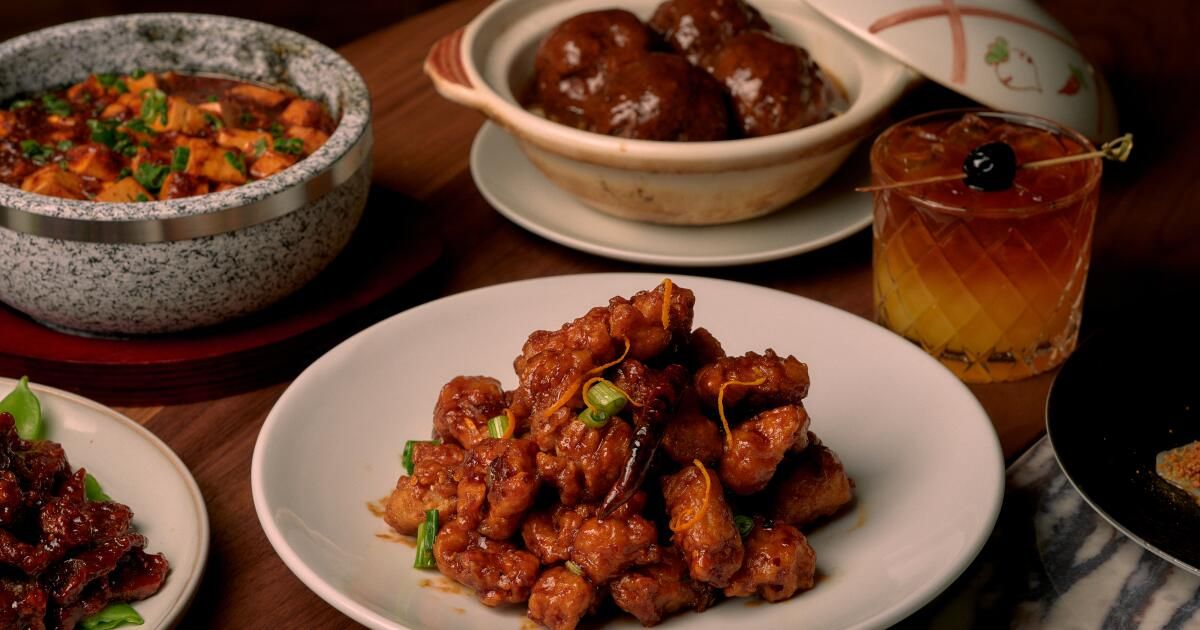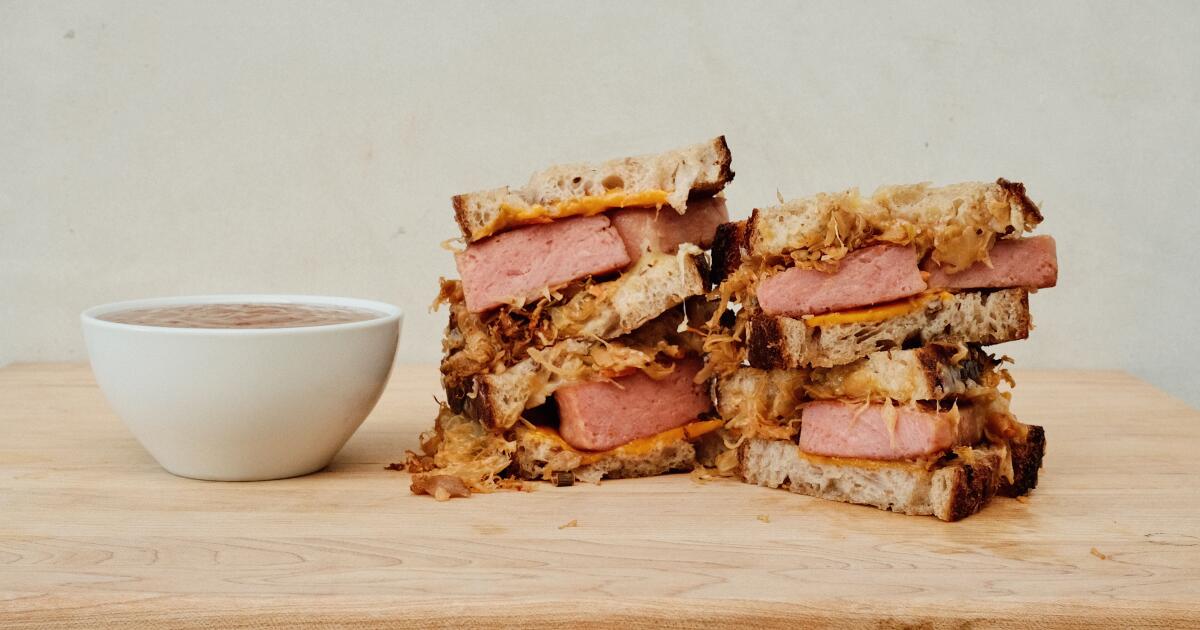The servers in the Panda Inn Restal Restal reopened in Pasadena slide around the dining room with massive trays that rise on their shoulders, each full of orange chicken plates, sour and sour soup bowls and pork orders Mu Shu. If the food were an Olympic sport, I would bet on the Panda Inn team.
For someone who grew up going to the original much darker and low ceiling restaurant, the new excavations of Panda Inn are unrecognizable. And a new brighter energy is palpable, with a dining room that swells with diners even in the middle of the afternoon.
The reservations for the afternoon tables and the day of time schedule schedule have been difficult to acquire, and the first question that will be received at the host counter is whether you have one.
A semicircular entrance path leads to the entrance of the recently remodeled Panda Inn, the restaurant that generated thousands of express panda.
(Shelby Moore / for the times)

The restaurant is divided into several dining areas, including private dining rooms with tables large enough for a small banquet.
(Shelby Moore / for the times)
Andrew Cherng and his father, chef Ming-Tsai Cherg, opened Panda Inn in a sling section of Fothill Boulevard in 1973. Andrew and his wife, Peggy, then they would present the first Panda Express in the Glendale Galleria Food Court a decade a decade a decade later.
Now, the Panda restaurant group includes more than 2,600 Panda Express locations worldwide and four Panda inns in southern California. The company is also a franchise and investor operator in restaurants such as Hibachi-San, Uncle Tetsu, Yakiya, raising Cane's and Whataburger.
In his previous incarnation, Pasadena Panda Inn was where you went before a school dance, met the family extended for birthday parties or found a Wednesday night because it was the only place where everyone could agree.
THE NEW PANDA INN
Last November, the restaurant reopened after a complete review and renovations that took almost two years to complete. Now it is a bustling American Chinese Brazerie in an area of the city known more for its chain shopping centers than destination restaurants.
The entrance, which once faced the mountains of San Gabriel, is now seen west, accessible beyond the type of crescent entrance that can be found in some of the city's late Mcmansions of the city. There is a luxurious red carpet that leads to the main door, flanked on both sides by two areas of outdoor seats.


The works of art with Chinese motifs said the bar, where you can ask for cocktails like drops of Yuzu lemon. Chef Aiguo Yang, executive chef of the newly remodeled panda inn. (Shelby Moore / for the times)
The dining room is very modern and more exclusive, with high roofs, warm wood walls and an elegant floor that shines like marble. The space is divided into five main sections, with private rooms, semi -private cabins hidden in made niches, a complete bar that throws Yuzu de Limón and even a sushi bar.
It can be different, but its heat is strangely familiar, remembering the barrels of chain dining rooms such as Din Tai Fung. While lunching with the attached editor of food Betty Hallock, he commented that although he had never been in the original, he somehow felt nostalgic.
Even if it has never dinner in an Inn Panda, it is likely to be familiar with the specific brand of American Chinese food that helped popularize. The dishes such as the orange chicken and chicken of General Tso became part of the great American culinary vernacular in the Woks of Panda restaurants.
On a recent visit, I heard a server tell your table that this is the original Chinese American restaurant. And yes, everyone orders orange chicken.
Panda restaurants may have made the greatest contribution to American Chinese cuisine in the last century. The most widely accepted history of origin for the orange chicken comes from Andy Kao, who is attributed China, first prepared. It is with chicken with leather bone.

One of Panda Inn's exclusive dishes is Panda's crispy beef, with an orange adjacent sauce and served with advanced snow peas.
(Shelby Moore / for the times)
Panda Inn is where beef and broccoli, fat mountains, chewable fun, soy stain and soup soup are all the apotheosis of the unconditional US Chinese. But the new Panda Inn is a restaurant that ambitiously reaches a broader audience, and the opportunity to convert more regional Chinese dishes into new classics.
He echoed the work of art behind the bar and in the new pages of the menu is an attempt to give life to the Cherg family trip to the United States. Panda Inn executive chef, Aiguo Yang, expanded the original menu with dishes that have roots in Yangzhou, China; Taipei, Taiwan; and Yokohama, Japan, all significant areas for the Cherng family.
The headballs of the stoofadas lion are a regional specialty of the province of Yangzhou, where they are Ming-Tsai and Yang. They come like four orbs from the size of the tennis balls (they are destined to evoke the head of the head of a Chinese guardian lion) submerged in a rich brown and thick sauce on a withered cabbage bed. They are soft, flexible and barely formed, such as juicy balls filled with dough ball.

The headballs of the stewed lion are a wink to the yangzhou roots of the founding family: Beef orbs barely supported in a brown sauce.
(Shelby Moore / for the times)
There is an attempt to style with some of the preparations of the table. Mapo Tofu is transferred from a bowl to a sizzling pot just before service. The presentation is a bit flop, but the Mapo Tofu is an exemplary version of the Sichuan dish, with soft and silky tofu in a deeply tasty red sauce. The heat is cumulative but not terribly aggressive in spices, and the pieces of chestnut of water offer freshness and crunch.
Yang said that almost 40% of the menu dishes are new, with articles such as Palomitas de Taiwanese chicken, representatives of the years that Ming-Tsai and Andrew lived in Taiwan. The geographical story of the Cherg family provides a loose passage line for the menu, but not all new additions fit perfectly.
The smoked duck salad with mango tea implies a bed of Roman lettuce with smoked floors, crispy wontons, fresh mango, honey nuts and fried potatoes with a sweet champagne dressing. It is an enigma of a salad that I ordered several times, trying to extract the logic of this particular combination of components. If I combine the banana chip with duck, will it make sense? What happens if I add a walnut to the party? I'm still undecided. One of my dining rooms simply called the “unfathomable” salad, but we continue to clean our dishes.

New in Panda Inn is the Sushi bar, where solo diners and couples often find seats without reservations. In the new menu: Sashimi de Platijas de Oliva.
(Shelby Moore / for the times)
A desire to honor Ming-Tsai's time as a chef in Yokohama means that there are a team of five people who prepare Nigiri, Sashimi and Maki in a dedicated Sushi bar. Hidden in the back of the restaurant, it is mostly populated with couples and singles who entered without reservations. But if you want to have an Omakase experience, chefs will force you.
The Sushi bar is where the American Chinese brand (which Panda restaurants have worked so thoroughly to establish) are confused in an excessive work in Fusion. Hong Kong -style shrimp with mayonnaise reinvent themselves as a shrimp tempura roll, but the best components of the plate, the crack of the shrimp, the balance of the sauce and the sweetness of the nuts, are lost in the rice.
Anguilla's squares extend over a squad of California burned and cut with a Mascarpone foam and the Chilean Anguilla sauce of the restaurant. The creamy Italian cheese and the eel are not great friends in a Maki roll.
If you intend to have sushi, Sashimi tends to be more focused. Oliva Platinge Astillas are sprinkled with dry walnut miso and go to a water sauce made from Yuzu and Ponzu.
What about orange chicken?
As for the famous orange chicken, the Panda Inn version is what you know and love the steam tray of the food court, only that it is served at a temperature that implies that it took a few seconds to reach your table, with a coating lighter and much more clear and an enamel that clings instead of going. The intense orange flavor is more citrus with solar soles than artificial and there is a heat whisper of Chile that cuts sweetness. All other orange chicken, either in the Chinese restaurant in your neighborhood, the freezer's hall or even in the Panda Express near you, will pale compared.
If this orange chicken knows better than you are remembering, it is because it is. According to chef Jimmy Wang, Executive Director of Innovation and Product Development in Panda Express, the Pasadena Panda Inn increased citrus fruits with the orange zest and the fight in the new recipe.
Wang said that they also made some adjustments to exclusive panda beef, a dish of crunchy and fried beef in revolt slices in a light, sweet and sour sauce. The specific process of frying leaves tender meat and brittle coating. The sauce is adjacent to the orange chicken but with a less specific citrus flavor.
Most people sitting in the Sushi bar are actually hunched over orange chicken or res panda meat plates.
The new Panda Inn is a Sushi bar, a Yangzhou treasure specialist and the Chinese American neighborhood restaurant you love. If you try to experience them all at once, you can feel a bit disarticulated. Choose one (or even two), and is exactly the place where you want to be.
Panda inn
3488 E. Fothill Blvd., Pasadena, (626) 793-7300
Prices: APPEPERS $ 15- $ 16, tickets $ 16- $ 48, desserts $ 8- $ 9
Details: Open from Sunday to Friday from 11 am to 9 pm and Saturday from 11:30 am to 9 pm full bar. Street parking.
Recommended dishes: The orange chicken, the beef, Yangzhou stoked the meatballs of the lion's head and the Mapo tofu.












